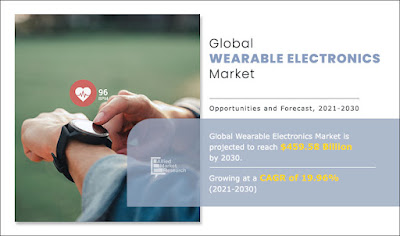Wearable Electronics Market to Witness an Outstanding Growth By 2030
Allied Market Research, titled, “Wearable Electronics Market Size by Product, Component, and Application: Global Opportunity Analysis and Industry Forecast, 2021–2030," the global wearable electronics market size was valued at $81.40 billion in 2020, and is projected to reach $459.58 billion by 2030, growing at a CAGR of 19.96% from 2021 to 2030.
Wearable electronics refers to an integrated computing
device or product, which helps the person or the user wearing it to enhance day
to day activities. The dawn of mobile wireless systems, smart phones, has
sparked a new era for wearable electronics globally. Gadgets which were deemed
to be just used in industrial & commercial applications have now found
their way into normal consumers enhancing their quality of life through various
applications such as healthcare, sports & fitness, and lifestyle among a few.
The prominent factor that drives the wearable electronics market growth include lower device cost due to the emergence of a large number of manufacturers and rise in awareness among customers for health-related activities and increase in usage amongst customers of varied age profiles for patient tracking systems. However, surge in number of customers adopting digital devices and presence of internet mobility is expected to hinder the growth of the wearable electronics market trends. Conversely, rise in investment on building a connected ecosystem is projected to offer remunerative wearable electronics market opportunities.
Wrist wear segment was the largest contributor of revenue in
2020 and is expected to grow at a CAGR of 17.5% from 2021 to 2030. Factor such
as advancement and innovations in smart watches by the key players help drive
the wearable electronics market. Body wear segment consumes 20.0% market share.
Surge in adoption of wearable devices such as smart watches, band, headsets,
gloves in manufacturing industry is one of the major factors for this
growth.
The global wearable electronics market is segmented into
product, application, and region. On the basis of product, the market is
fragmented into wrist-wear, eye-wear, body-wear and other-wear. Moreover,
application segment is divided into healthcare, entertainment, industrial, and
others.
Region wise, the wearable electronics market is analyzed
across North America (U.S., Canada, and Mexico), Europe (Germany, UK, France,
Italy, and rest of Europe), Asia-Pacific (China, Japan, South Korea, India, and
rest of Asia-Pacific), and LAMEA (Latin America, Middle East, and
Africa). The market share in Asia-Pacific is expected to grow
at a faster rate as compared to other regions. Factor such as rapid
technological advancements & innovations and transformation from automated devices
to autonomous devices due to the integration and advancement of IoT and AI
technologies increases the demand for wearable electronics industry.
COVID-19 Impact Analysis
The global wearable electronics market size has been
significantly impacted by the COVID-19 outbreak. New projects throughout the
world have been stalled which, in turn has declined the market growth. In the
present pandemic scenario, health has become an utmost priority for people so
demand for wearable products related to health and fitness such as fitness
bands and smartwatches is expected to increase significantly.
Key Findings of the Study
- In
terms of revenue and volume, the wrist wear segment contributed the
maximum wearable electronics segment in 2020, and is expected to maintain
its lead throughout the wearable electronics market forecast period.
- In
2020, North America accounted for over a 29% share globally, and is
witness significant growth in wearable electronics market share.
The key players profiled in the report include Adidas AG,
Fitbit, Inc., Nike, Inc., Google, Inc., Apple, Inc., Sony Corporation, Samsung
Electronics, Garmin Ltd., Sensoria Inc., and LG Electronics. Market players
have adopted various strategies such as product launch, collaboration &
partnership, joint venture, and acquisition to expand their foothold in the
wearable electronics market.




Comments
Post a Comment